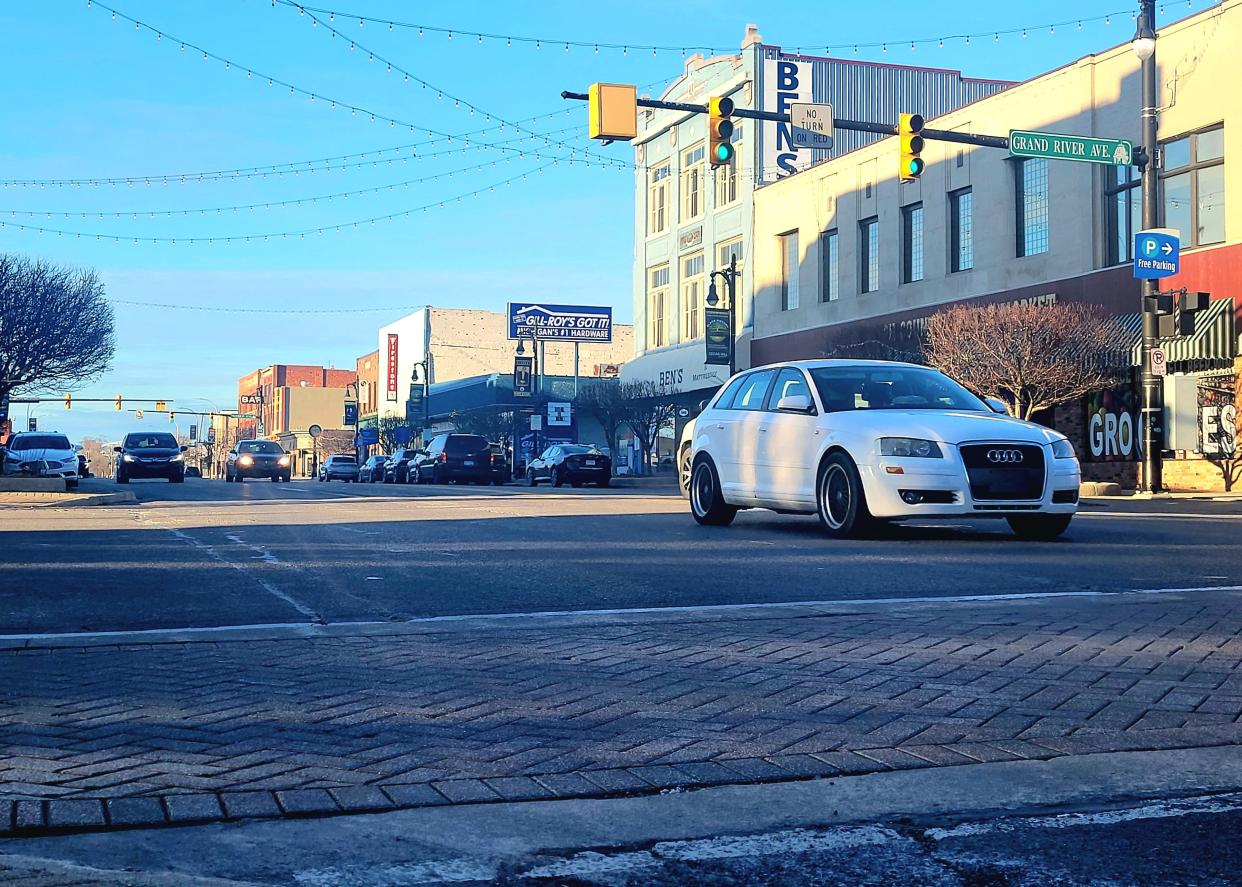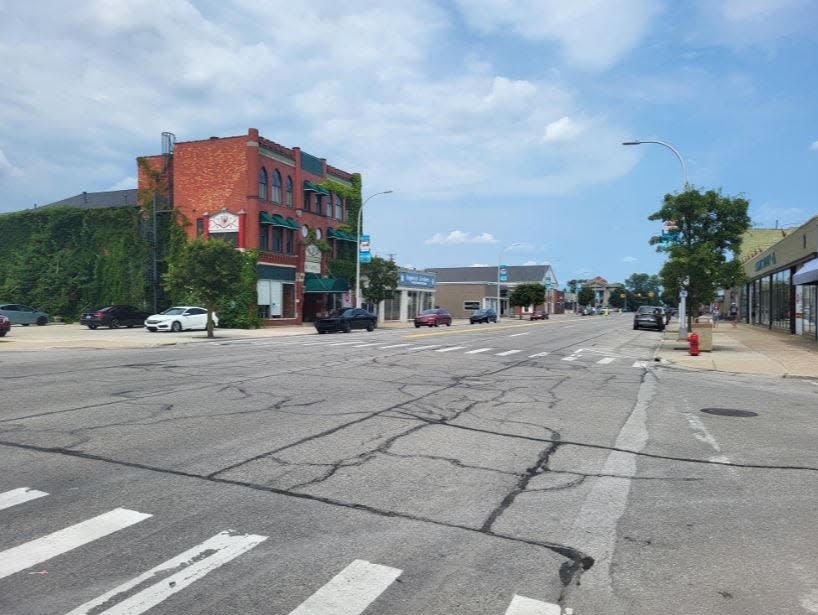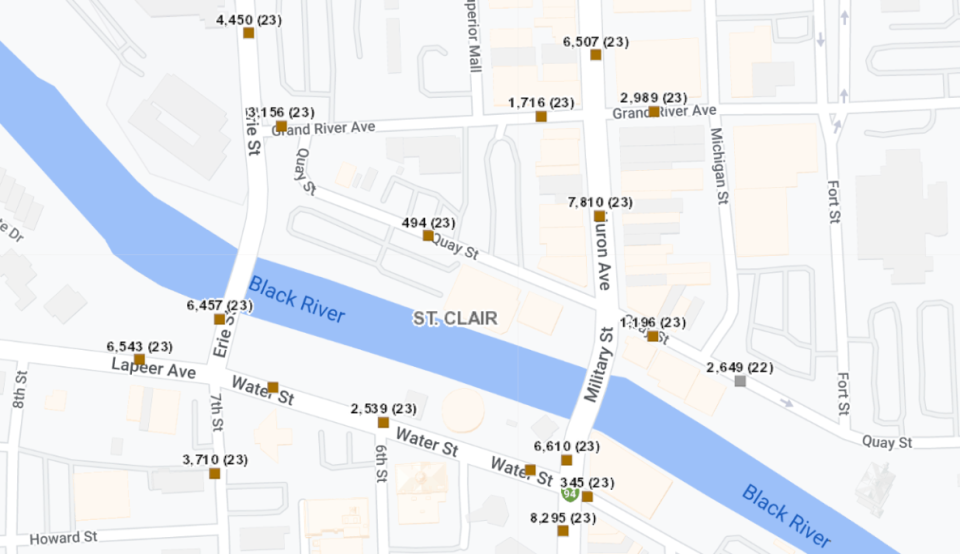MDOT: Impacts of Huron Avenue, Blue Water Bridge plaza construction won't intersect

Things may look dramatically different in a few years for motorists traveling through central Port Huron — namely, the northern half of downtown and north up Pine Grove Avenue — depending on the outcome of two imminent major state transportation projects.
Reconstruction of Huron Avenue from the Military Street Bridge to Glenwood Avenue is expected to kick off in spring 2026 amid the early phases of construction to expand and reconfigure the U.S. Customs Plaza around the Blue Water Bridge.
Although overall plans at the plaza include constructing a new intersection for 10th and Pine Grove avenues to accommodate a relocated off-ramp, officials with the Michigan Department of Transportation said the ongoing bridge plaza work would be limited to the plaza footprint, isolating traffic disruptions in two years to Port Huron’s downtown.
Still, some local business owners and city officials said they’re concerned about the looming impact of the Huron rebuild and what it means for Main Street storefronts long-term.
“The downtown is mortified that they’re already going to be choked off from Fort Gratiot and the northern part of the city because of the plaza project, and then, rip up our downtown at the same time,” City Manager James Freed told City Council members during a special meeting last weekend. “If you wanted to drop an economic bomb on Port Huron, I don’t think MDOT could do a better job than what they have planned.”
When asked this week, multiple business owners along Huron Avenue declined to comment on the 2026 reconstruction, though some expressed broad concern for the impact closures would have during the project.
Meanwhile, others said they hoped the state would utilize the reconstruction as a chance to roll out a new design for the roadway and its streetscape — benefiting businesses and the community longer-term.
MDOT regional spokesperson Caitlyn French said the department was beginning the design process for the project, which will include the removal and replacement of all pavement, curb and gutter, traffic signals, and storm sewers.

To help get an idea of the public response to their plans for traffic control and the project, MDOT launched an online input survey Tuesday via Michigan.gov/MDOT.
That link, which includes how to reroute the business loop for interstates 94 and 69 that swoops through downtown, is active through May 3.
“In the survey, we ask stakeholders to consider three traffic control plans: A full closure and detour, a partial closure with one lane open in each direction, and a partial closure with one direction of traffic maintained,” French said via email. “All three options have different impacts on work zone traffic, pedestrian access, on-street parking, and side-street access.”
What are the project details? Is there an expected economic impact?
The plaza expansion at the Blue Water Bridge has been nearly two decades in the making.
Planning for the massive project picked up steam with a $25 million federal infrastructure grant in 2020 with public feedback sessions near the start and end of 2023.
According to proposed timelines displayed by MDOT at a session last November, the addition of a new eastbound I-94/69 exit to M-25 on Pine Grove and the reconfiguration of its intersection with 10th Avenue was slated for construction this year and in 2025 — ahead of the downtown construction.
Other early phases are expected from 2025 through 2027, including relocating the Duty Free to the south side of the bridge with a new entrance loop. The state agency is still raising funds for later phases.
Downtown on Huron, reconstruction will also mean repairs to the Military Street Bridge over the Black River and replacing some municipal utilities.
It wasn’t clear if the design phase for Huron’s rebuild considered a local economic impact. When asked, "During the planning stage, MDOT models traffic impacts to determine expected delays," pointing to the city and federal alternative transportation funds that can be used to help address beautification needs in a downtown business district.
French also said, “We will continue to engage with stakeholders in the future, including returning to City Council meetings to share more information on the project.”
MDOT officials presented general Huron Avenue plans to council members last summer, adding they'd expect to pause during or work around Boat Week celebrations, and sat down with some members of the downtown business community in early August.
For city leaders, a big part of the concern was reconstruction of Huron’s streetscape.
Freed had pointed to the impacts on businesses in other Michigan communities when their streetscapes were redone, later reiterating questions about what the book-end effect would be when combined with the plaza.
“I am very concerned that there would be the construction at the bridge, which is already in the minor utility work they’re doing now, greatly impeding traffic flow to the downtown,” he said Monday. “Already we are seeing the impacts of people not wanting to traverse that section of roadway because it’s so congested and only one lane’s closed right now. My concern is that to immediately begin a massive construction project in downtown while that’s going on, you have two major projects going on in the same affected area. No one’s looked at the economic impacts of that to downtown from MDOT.”

What are the concerns? What should the new Huron Avenue look like?
The reconstruction on Huron would also follow the first couple of years businesses have had to grow following the post-pandemic slump, particularly in retail. Many storefronts along Huron have secondary entrances that would still allow them to accommodate customers even if sidewalk work obstructs their main entrances.
For some, however, such as at District 43, there’s just one way for visitors to enter, and the worries weigh heavier.
“I think my level of concern would be at 70% regardless, but I would be a little less concerned if I had a different way for people to get to my store,” said Jorja Baldwin, who owns the shoe store. “From a District 43 standpoint, I’m very concerned because they have to tear up the sidewalk, as well, and so, I don’t know how you provide access with that.”
“Obviously, I don’t think the sidewalk is going to be cut off the entire time,” she said, “but there will be a timeframe where I don’t know that my store would be accessible. I don’t think that is fully answered yet.”
Challenges or not, there were a few things local business owners and other residents who keep up on city issues agreed on.
More than anything else? Change the layout of the roadway and streetscape with something that’s more multimodal.
Resident Tyler Moldovan frequently provides commentary on urban planning and transit issues on social media, including via a “Huron Ave Reimagined” Facebook page.
He said he hoped to see a road diet downtown — similar to that of the state throughway in St. Clair — and last August, he shared a response to his input from Linda Burchell, manager of MDOT’s Huron Regional Transportation Service Center: “Our decision will not be exclusive to motor vehicles. Non-motorized will be considered along with the queuing impacts from the lift bridge operations, as well as parking impacts for various adjacent businesses.”
Like the community, MDOT appeared to be weighing all the options, too.
In an interview Thursday, Moldovan said he felt an “incredible urgency” for city leaders to “get with the program” about using the Huron project to makeover the downtown, emphasizing his belief that their input holds more sway with MDOT than they realize.
“I don’t think the city has properly set up or invested in 21st-century infrastructure that younger generations of people want to set these businesses up for success in the first place,” he said. “We keep adding more parking … as if that will solve the problem.
“It is more about the public realm. That’s, I guess, what I want to stress the most. That is what individual business owners cannot change, and this is an opportunity we have to change that. It’s going to be another 20, 25 years before this comes up for construction again. And me as someone who wants to raise a family in Port Huron, I would hope that before my kids graduate high school, that I would be able to safely walk or bike with my kids downtown to get breakfast at Maria’s on Saturday morning. But if we just repave over exactly as it is now and continue the mistakes of the 1960s, that’s just not a reality.”
Steve Fernandez, co-owner of Country Style Market, also named a road diet — narrowing sidewalks in a more historical fashion, and as a personal preference, adding diagonal parking.
“And just have one lane going in each direction to slow down traffic,” he said, referring to the classic aim of a “road diet” in mitigating the flow of vehicles by decreasing the number of travel lanes. “Right now, if you were to stand out here, you would be appalled. If you just sat out here and watched how fast people drive up and down this road. There’s nobody doing 25. They’re doing 35 and 40 miles an hour.”
MDOT's survey released last week also particularly asks about going from two directional lanes to one with a center turn lane, as well as options to include a landscaped median, bike lanes, or larger sidewalks.
Previously, city officials have pointed to concerns with vehicle stacking when the Military Street Bridge goes up as a potential reason a road diet may not be feasible for Port Huron.
But Moldovan disagreed, pointing to the numbers discoverable via MDOT’s data management system. The city of St. Clair has a drawbridge, too, but its average daily traffic counts before and after its road diet reduction in lanes has remained the same, roughly around 10,000.
In Port Huron, with two other drawbridges, traffic could adapt and reroute naturally, Moldovan said. As of 2023, Main Street traffic north and south of the Military Street bridge averaged over 7,800 and 6,600 daily, respectively. That’s versus over 6,400 daily just south of the Seventh Street Bridge.
Resident Jim Soto, who frequently advocates for better bike-friendly infrastructure, said he thought road diets often help boost foot traffic and sales for businesses.
“I support a road diet with separated bike lanes, because studies consistently show that streets becomes safer for all road users,” he said in a message. “… Local retailers often bemoan the lack of foot traffic and sales, so changing Huron Ave. could go a long way toward helping downtown businesses. Huron Avenue's current design is from 1993, so we have 30 years of evidence to test if the current design has helped or hurt the city and downtown businesses. I think the evidence is clear that the current configuration is not working and should be changed.”
Contact Jackie Smith at (810) 989-6270 or jssmith@gannett.com.
This article originally appeared on Port Huron Times Herald: MDOT: Impacts of Huron Ave., Blue Water Bridge plaza construction won't intersect

